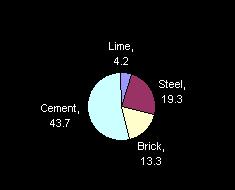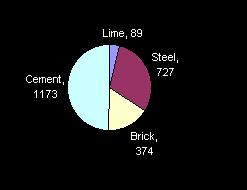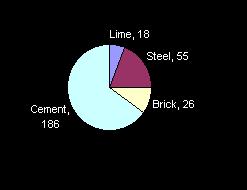|
The
Construction Sector in India and Climate Change * Steel * Cement * Bricks * Lime For each of the four building materials, there exists a technology spread characterised by widely varying levels of energy and material consumption within each sector. The total energy and emissions for 1989-90 for these four building materials are 742.5 peta joules and 80.5 million tones of CO2. The energy and emission levels were arrived at as a function of technology and scale of production (Table 1). A study conducted by Development Alternatives discussed the increasing demand for building materials in the construction sector as a direct outcome of the galloping demand for housing on a continuing growth trend of 2.4% per annum aggregate cumulative growth rate. The housing gap which is currently 30.8 million houses will be steadily cleared by the year 2011 AD. Housing will finally be provided to the entire population estimated to be 1308 million according to the low growth scenario in 2020 AD. The nature of building materials used in housing has been taken to be 75% of the permanent type as per trends upto 1991. Beyond 2001, the growth rate has been revised downwards to conform to the population growth rate. The housing gap is likely to be closed by 2011 if the projected trend persists. The summary of the total energy and emissions for the four materials derived through the Developmen Alternatives study has been presented in Table 2. The energy and emissions upto 2020 have been computed using specific energy consumption and carbon emission factor. Although steel and cement together constitute more than two-thirds of the net contribution, these are sectors that are showing positive signs of adopting energy efficiency measures.
Future Scenario At Table 3 on Page 4, energy consumption per tonne of material (1000 bricks in case of bricks) and the emission for different levels of technologies, viz, business-as-usual, best practice and new technologies show the mitigating impact that best practice and new technologies can make on the climate change causative factors. Going by `business-as-usual`, the energy need for 2020 AD works out to 2363 PJ for the construction sector. If the `best practice’ route is followed, a 17% reduction is possible and if new technologies are adopted, a reduction of 25% in energy consumption is achievable.
Shelter is a basic need and is high on India’s national priority. The Construction Sector stands out as one of the areas for North/South collaboration at the industry level in the interest of abatement of global warming. Source : "Case Study for Construction in India" - by Development Alternatives in "Structural Transformation Process towards Sustainable Development in India and Switzerland" - published by INFRAS publication, Zurich. q |
||||||||||||||||||||||||||||||||||||||||||||||||||||||||||||||||||||||||||||||||||||||||||||||||||||||||||||||||||||||||||||||||||||||||||||||||||||||||||||||||||||||||||||||||||||||||||||||||||||||||||||||||||||||||||||||||



